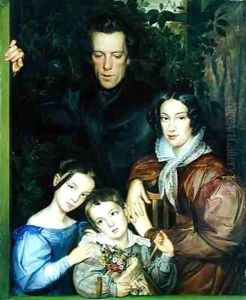Johann Friedrich Dieterich Paintings
Johann Friedrich Dieterich was a German artist known for his work in the realm of printmaking. Born in 1727 in the duchy of Brunswick-Wolfenbüttel, which was then part of the Holy Roman Empire, Dieterich's artistic journey began in an era marked by the Rococo style, although his works would later reflect the transition to Neoclassicism.
Dieterich's early life and training aren't well-documented, but it is known that he worked extensively as an engraver. His style was initially influenced by the ornamental and decorative qualities of the Rococo period, characterized by elaborate ornamentation, asymmetrical values, and pastel color palette. However, as the 18th century progressed, Dieterich, like many of his contemporaries, was drawn to the emerging Neoclassical style, which sought to revive the simplicity and purity of the arts of Rome and Ancient Greece.
Throughout his career, Johann Friedrich Dieterich specialized in creating copperplate engravings, a meticulous process that involves incising a design onto a copper plate, which could then be inked and used to produce prints on paper. This technique was popular for reproducing works of art, as well as for creating original compositions. Dieterich's engravings often featured portraits, religious scenes, and illustrations for books, reflecting the intellectual currents and artistic tastes of his time.
Although Dieterich may not be as widely recognized as some of his contemporaries, he contributed to the rich tapestry of European printmaking in the 18th century. His works are representative of the shifting aesthetic ideals of his time and provide valuable insights into the artistic and cultural transitions that occurred between the Rococo and Neoclassical periods.
Johann Friedrich Dieterich passed away in 1807. His legacy, like that of many artists of the period, is preserved in the collections of museums and libraries, where his prints continue to be studied by art historians and enthusiasts who appreciate the craft of traditional printmaking and the historical context of his imagery.
